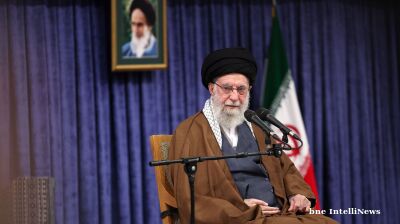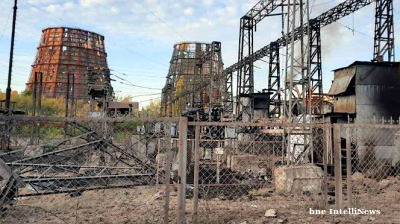A second round of peace talks between Russia and Ukraine concluded on March 3 with no progress. According to reports, that means an assault by the Russian forces on Kyiv has become much more likely.
The two sides met in the Brest region of Belarus on the Ukrainian border to continue negotiations, but the respective positions remain wide apart, according to reports from the meeting.
"To our great regret, we did not get the results we were counting on," Ukrainian presidential adviser Mykhailo Podolyak said.
There is still some time to find a compromise. Both sides said will meet for the third round of negotiations “probably in the nearest time.”
Both sides said they wanted a possible ceasefire for evacuating civilians through humanitarian corridors.
Russia's Foreign Minister Sergey Lavrov had said prior to the meeting that Moscow was ready for talks to end the fighting in Ukraine but would continue to press its effort to destroy Ukraine's military infrastructure.
Ukrainian Foreign Minister Dmytro Kuleba said his country was ready for talks to resume, but added that Russia's demands had not changed and he would not accept any ultimatums.
The Kremlin called for peace talks over the weekend and the first round was held on February 28, where the Kremlin laid out its demands, but ended inconclusively.
The Kremlin produced a shopping list of demands, many of which will be unacceptable to Kyiv, including recognition of Russia's hold on Crimea. While the Kremlin has asked Kyiv to declare neutrality and Kyiv responded that it was “open to the idea,” also on the list of demands is that Ukraine “denazify”, “demilitarise”, recognise the independence of the Donetsk and Luhansk regions, and recognise Russia’s ownership of Crimea.
The Ukraine delegation said that it would not concede to any compromises unless Russia first implemented a ceasefire and withdrew its forces. Russian President Vladimir Putin ordered an attack on Ukraine on February 24 and since then the Russian army has been occupying the regions along the north and east of the country as well as launching missile strikes at multiple cities and towns across Ukraine.
The UN reported this week that more than 1mn Ukrainians have been displaced, most of which have gone west to try to cross the border into the EU. Poland reports that it has already received more than 600,000 refugees, many of which have friends and family in Poland. The migration is the largest since World War II.
The failure of the second round of talks bodes ill and suggests that a full-scale assault on Kyiv could be imminent. As bne IntelliNews has reported in an op-ed “game of chicken”, Putin has been increasing the threats incrementally to try to put Ukrainian President Volodymyr Zelenskiy into a position where he has no choice but to concede to Russia’s demands.
Zelenskiy looked tired and stressed at a press conference given to the international media on March 3. He lambasted the West for not going far enough to guarantee Ukraine’s security, although he said he was grateful for the western support in the form of weapons and sanctions. However, he called for the West to “close the skies” above Ukraine, clearly fearing a large-scale aerial attack that may come at any moment.
"If you can't close the sky now, then give a deadline when it will happen. If you can't do it now, tell me how many people have to explode, how many arms, legs, heads have to fly to reach you? Tell me how many. I'll go to count and wait for this moment," Zelenskiy told reporters.
At each stage Putin has turned the pressure up dramatically but then called for a pause to hold talks and present his demands. So far there have been two rounds of diplomacy, the first with the US that started with a meeting on January 10 in Geneva that came to nothing when the US turned down Putin’s demand for legal guarantees that Ukraine would never join Nato in a letter delivered at the end of that month. A second round of diplomacy led by French President Emmanuel Macron in February that focused on implementing the Minsk 2 agreements also failed at the end of that month.
The third round is currently being played out, where Putin has brought the army into play. However, despite the destruction caused by the rockets, the fighting has been relatively low key so far, with some 250 Ukrainian civilians reported dead and just under 500 dead Russian combatants and with just over 1,500 wounded, according to unconfirmed official estimates.
Once again, the Kremlin was quick to call for a pause after only week following the start of the military operations. If these talks fail then Putin is likely to go to a fourth and much more destructive phase where Ukraine’s capital could be stormed.
A large military convoy is in place about 40 km north of Kyiv threatening the city. Special battle-hardened Chechen fighters have also been brought in and deployed in Ukraine near Kyiv, according to bne IntelliNews’ correspondent on the ground, Neil Hauer.
“It is unknown how many soldiers Kadyrov has sent to Ukraine, but the number is significant. Most reports indicate approximately 10,000 have been deployed; the highest figures range up to (a highly improbable) 70,000. More are being actively recruited, too: A source in Grozny provided a video on February 25 that shows thousands of men being gathered and equipped for duty in Ukraine. Audio recordings of conversations between Kadyrov and other Russian officials reveal that the Chechen ruler was one of the few figures made aware of Putin’s plans for a full-scale invasion in the run-up to the event,” Hauer reports.
“Already, Kadyrov’s forces have played a key role in the offensive. Chechen Rosgvardiya (National Guard) troops were spotted north of Kyiv on February 27, trudging through the Chernobyl nuclear exclusion zone toward the Ukrainian capital. Other sources suggested their involvement in the assault on Kyiv’s western suburbs and the crucial Hostomel Airport in fighting following the Russian paratrooper landing there on the first day of the war,” Hauer added.
The threat of an assault on the Ukrainian capital is palpable and may be given the go-ahead if Putin believes that the talks taking place on the Belarusian border are going to go nowhere. So far the Kremlin has been patient.
Putin told Macron in a phone conversation over the weekend that Kyiv has to concede to the Kremlin’s demands made at the talks and if it didn't, “We will take them militarily.”
“Russia’s offensive in Ukraine could intensify further in the coming several days as its forces target key Ukrainian cities,” consultant Teneo said in a note. “If the advancement of Russia’s armed forces stalls, the Kremlin might resort to more extreme measures to achieve its objectives.”
Following a few days of regrouping and resupplying, Russian forces are intensifying the offensive in Ukraine along multiple axes, Teneo reports. Their progress is most notable in southern Ukraine, where the city of Kherson (population around 300,000) has now fallen under Russian control. This paves the way for Russian movement towards Mykolayiv (500,000) and Odesa (1mn). The control of these cities and surrounding areas would essentially block Ukraine’s access to the Black Sea coast, with the ensuing economic and strategic consequences for Ukraine.
“In the capital Kyiv and the second-largest city Kharkiv, Russian forces are resorting to increasingly heavier air and artillery strikes, causing significant civilian casualties and damages. Heavy bombardment and attempts to encircle Kyiv will likely persist in the coming days. In the meantime, the Ukrainian side intends to step up its counter-offensive operations, likely reinforced by new deliveries of military equipment from the West,” Teneo adds.
As both sides prepare for intensified military action in the coming days, Russia and Ukraine reportedly agreed to open the humanitarian corridors for the evacuation of civilians on March 3.
News

Iran's Khamenei calls Trump a 'real terrorist'
Iran's Supreme Leader Khamenei tells Trump "what business is it of yours" regarding nuclear industry, calling US president's positions lies and bullying whilst rejecting claims of supporting Iranian people.
-fotor-bg-remover-20251020114620.png)
Bolivia elects centrist Rodrigo Paz to lead a nation in chaos
Bolivia has entered a new political era after Rodrigo Paz secured the presidency with 54.5% of the vote, defeating former conservative leader Jorge “Tuto” Quiroga.
_seen_here_meeting_with_Congressman_Jimmy_Panetta_201025_Cropped_1760946356.jpg)
Kazakhstan renews push for lifting of Jackson-Vanik trade restrictions
Visiting Astana official hopes for “speedy resolution.”




